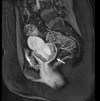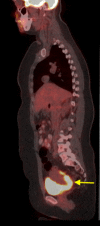A Rare Case of Clear Cell Adenocarcinoma of the Cervix with No Intrauterine Diethylstilbestrol Exposure
- PMID: 32461864
- PMCID: PMC7243845
- DOI: 10.7759/cureus.7796
A Rare Case of Clear Cell Adenocarcinoma of the Cervix with No Intrauterine Diethylstilbestrol Exposure
Abstract
Cervical cancer is the fourth most common cancer in females. Clear cell adenocarcinoma of the cervix is an uncommon histological variant and is usually seen with intrauterine exposure to diethylstilbestrol. A 28-year-old female with no intrauterine exposure to diethylstilbestrol presented with postcoital bleeding. A pelvic exam revealed a cervical mass. Imaging confirmed the cervical mass and positron emission tomography scan showed an increased uptake in the cervical mass as well as the para-aortic and pelvic lymph nodes. Biopsy showed a clear cell carcinoma of the cervix. She was treated with cisplatin and paclitaxel for eight cycles and concurrent radiation therapy. She had a complete response to therapy and has been in complete remission nine months from the end of therapy. There are no clear guidelines for the treatment of clear cell carcinoma with current therapy based on the treatment of squamous and non-clear cell adenocarcinoma. Cisplatin and paclitaxel could be an option, given the successful treatment of the patient in our case.
Keywords: cervical cancer; cervical clear cell carcinoma; cisplatin; clear cell adenocarcinoma of the cervix; clear cell cancer; diethylstilbestrol; paclitaxel.
Copyright © 2020, Mathew Thomas et al.
Conflict of interest statement
The authors have declared that no competing interests exist.
Figures





Similar articles
-
A Rare Case of Clear Cell Cervical Carcinoma to a Woman, 50 Years After Diethylstilbestrol Exposure for Lactation Suppression.Cureus. 2021 Aug 26;13(8):e17468. doi: 10.7759/cureus.17468. eCollection 2021 Aug. Cureus. 2021. PMID: 34589362 Free PMC article.
-
Primary Clear Cell Adenocarcinoma of the Uterine Cervix in a 14-Year-Old Virgin Girl: Case Report.Int J Environ Res Public Health. 2022 Dec 11;19(24):16652. doi: 10.3390/ijerph192416652. Int J Environ Res Public Health. 2022. PMID: 36554533 Free PMC article.
-
Colposcopic and pathologic features in two cases of DES-related vaginal clear-cell adenocarcinoma.J Reprod Med. 1983 Feb;28(2):137-46. J Reprod Med. 1983. PMID: 6834354
-
Long-term remission of clear cell carcinoma of the cervix after chemoradiation with 109 cycles of paclitaxel: a case report and literature review.Eur J Gynaecol Oncol. 2017;38(3):456-458. Eur J Gynaecol Oncol. 2017. PMID: 29693891 Review.
-
Clear cell adenocarcinoma of the uterine cervix: a case report and review of the literature.J Pediatr Hematol Oncol. 2014 Mar;36(2):e131-3. doi: 10.1097/MPH.0b013e318290cb1b. J Pediatr Hematol Oncol. 2014. PMID: 23669724 Review.
Cited by
-
An Unexpected Case of Clear Cell Adenocarcinoma of the Cervix in a Non-Diethylstilbestrol-Exposed Postmenopausal Woman.Cureus. 2024 Dec 20;16(12):e76083. doi: 10.7759/cureus.76083. eCollection 2024 Dec. Cureus. 2024. PMID: 39835055 Free PMC article.
-
A Rare Case of Clear Cell Cervical Carcinoma to a Woman, 50 Years After Diethylstilbestrol Exposure for Lactation Suppression.Cureus. 2021 Aug 26;13(8):e17468. doi: 10.7759/cureus.17468. eCollection 2021 Aug. Cureus. 2021. PMID: 34589362 Free PMC article.
References
-
- Cervical cancer: a global health crisis. Small W Jr, Bacon MA, Bajaj A, et al. Cancer. 2017;123:2404–2412. - PubMed
-
- Adenocarcinoma of the vagina: association of maternal stilbestrol therapy with tumor appearance in young women. Herbst AL, Ulfelder H, Poskanzer DC. N Engl J Med. 1971;284:878–881. - PubMed
-
- Gynecologic Cancer InterGroup (GCIG) consensus review for clear cell carcinoma of the uterine corpus and cervix. Hasegawa K, Nagao S, Yasuda M, et al. Int J Gynecol Cancer. 2014;24:90–95. - PubMed
-
- Clear cell adenocarcinoma of the uterine cervix: a case report and review of the literature. Baykara M, Benekli M, Erdem O, et al. J Pediatr Hematol Oncol. 2014;36:131–133. - PubMed
Publication types
LinkOut - more resources
Full Text Sources
